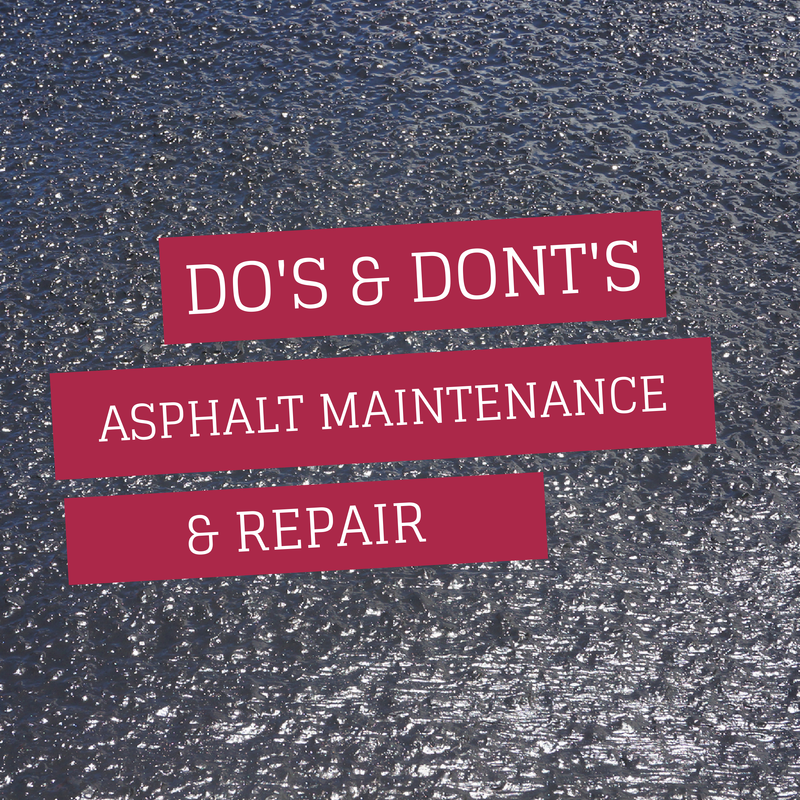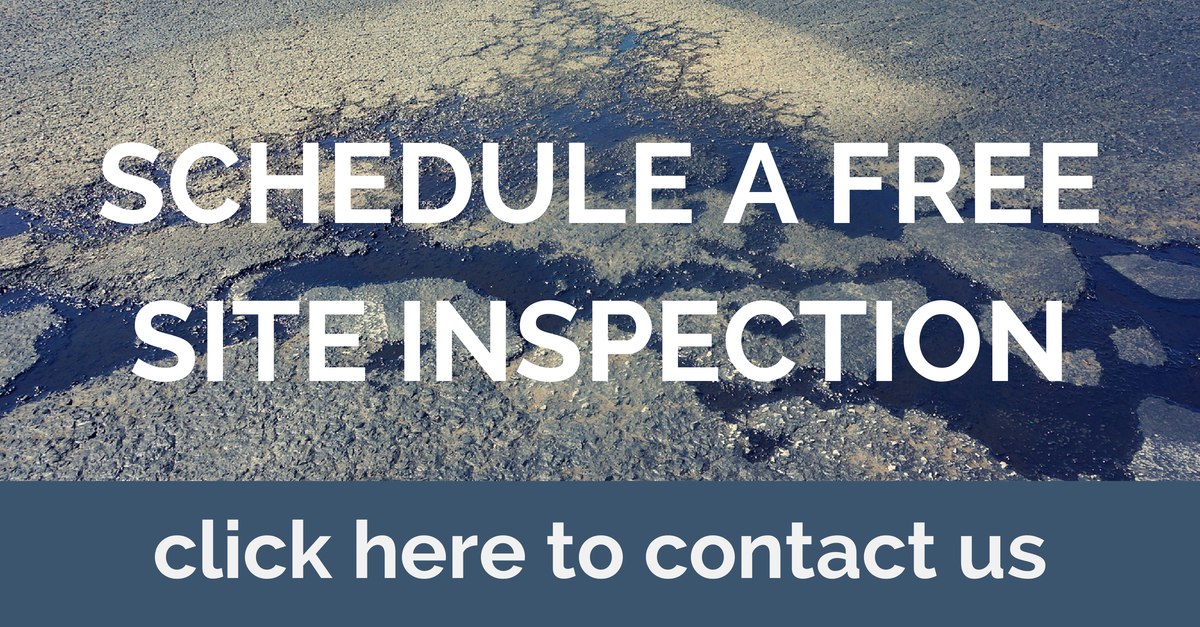
Asphalt maintenance and repair is a lot more than repaving. In fact, repaving is usually going to be your last resort. There are a number of things you can do (and not do) to extend the life of your asphalt pavement. But the most important part of maintenance is being preemptive: you've got to keep your good pavement good. This means treating your pavement before any serious deterioration starts.
Below are five DO's and DON'Ts for asphalt maintenance and repair.
DON'T allow your asphalt to become oxidized
Oxidation occurs when your asphalt is exposed to oxygen and the sun's UV rays without any protection. The binder (or glue) that holds together your asphalt (which is made of aggregates and sand) breaks down causing raveling on your surface. Oxidized asphalt is also brittle, and it becomes more prone to cracking.
You'll be able to tell when your asphalt is oxidized because it will have a gray color versus a dark black color that new asphalt has.
DON'T let sprinklers direct water onto your asphalt
If you have sprinklers near your parking lot, make sure that they don't direct water onto your asphalt. Water is one of the top reasons for pavement degradation. If water penetrates into your pavement, it softens the base course which can cause depressions in your pavement and ultimately lead to potholes (which will then allow even more water into your pavement).
DON'T allow heavy loading on your asphalt
Extremely heavy vehicles, such as garbage trucks, put an enormous amount of stress on your pavement. If your asphalt pavement already has cracks or a damaged base course, the stress of the heavy vehicle will only deteriorate the pavement more.
If you have to have heavy vehicles on your asphalt, consider installing a concrete pad where these heavy vehicles frequent.
DON'T neglect pavement maintenance
When it comes to asphalt, small issues turn into larger ones quickly. If you don't protect your asphalt, it will become oxidized, which will lead to cracks. Cracks allow water into your base course, and when your base course's integrity is compromised, you end up with depressions in the pavement and potholes. However, if you address cracks and other issues in a timely manner, you can prevent your asphalt from degrading to that point. Common pavement maintenance tasks are: seal coating, crack filling, oil stain removal, pothole repair, and striping and marking.
DON'T always pick the bid with the lowest price
When it comes to finding a contractor to perform the work, whether it be seal coating, crack filling, pothole repair, etc., you may be fixated on the lowest price. However, it's important to make sure you're comparing apples to apples, and not apples to oranges.
Two bids may vary in price because the scope of work may be different for each bid. Read our "DO" to learn why.
Now, onto the "Do's":
DO sweep your asphalt pavement at least once a year
Sweeping your asphalt removes loose gravel from your surface, improving its appearance. It also allows you to inspect your asphalt for cracks and depressions that could indicate early pavement degradation. The sooner you can catch signs of degradation, the sooner you can take preventative actions such as crack filling and seal coating.
DO sealcoat your asphalt every three to five years
A sealcoat acts as a barrier that protects your asphalt's surface from oxidation and water penetration. It's like sunscreen. Just as sunscreen is used to protect your skin, a sealcoat protects your asphalt surface. But like sunscreen, a sealcoat needs to be reapplied! For most situations, you should be OK if you sealcoat your asphalt once every three to five years. You may need to do it sooner if your parking lot experiences heavy/constant traffic.
DO crack fill as soon as possible
Cracks allow water to penetrate into your pavement and degrade your base course. Once you've got a base course failure, you'll get more cracks in your pavement which will lead to alligatoring and potholes. Therefore, it's very important to prevent water penetration, and filling cracks in a timely manner is imperative.
DO plan to repair potholes even if you've used a pothole patching material
Most off-the-shelf pothole patching materials deteriorate quickly. In these cases, you may need to go back and repair/re-patch the same pothole again in a month or two. Our pothole repair material, called Instant Road Repair, provides you with longer relief (about a year), but in the end, you still will need to actually fix the pothole. Remember, a pothole forms because the base course is damaged. Using a patch fills the hole to prevent more water penetration, but it does not fix the damaged base course. When we say "fix" the pothole, we mean cut out the damaged area and pour new asphalt and re-compact.
DO specify job scope when soliciting bids
If you ask for pricing from two different contractors without a scope of work, you could get two wildly different prices. For example, Contractor A may provide a price for just seal coating while Contractor B may provide a price for crack fill, pothole repair, and seal coating. Of course Contractor A will have the lower price, but Contractor B may provide a more complete pavement maintenance plan.
You need to consider what needs to be done. Some areas of your asphalt may be so far gone that you need to repave (in which seal coating the area is a waste of money). Another area may just need a sealcoat while a third area may need cracks to be filled before seal coating. With so much variables, this is why it's so important to have your asphalt pavement inspected and to come up with a scope of work before soliciting bids.
We help you specify scope of work
We provide project management services for asphalt maintenance and repair. We'll help you plan the scope of work, write the specs for you, solicit bids, and help your property management team go through the specs and bids. Call (or email) us and we'll inspect your site and come up with a scope of work and provide recommendations of what you should be doing to maintain/repair your asphalt pavement.
 Travis is the Marketing Coordinator for GP Roadway Solutions and its divisions GP Maintenance Solutions, Peterson Sign Company, and Unistrut Hawaii. Connect with Travis on LinkedIn.
Travis is the Marketing Coordinator for GP Roadway Solutions and its divisions GP Maintenance Solutions, Peterson Sign Company, and Unistrut Hawaii. Connect with Travis on LinkedIn.

